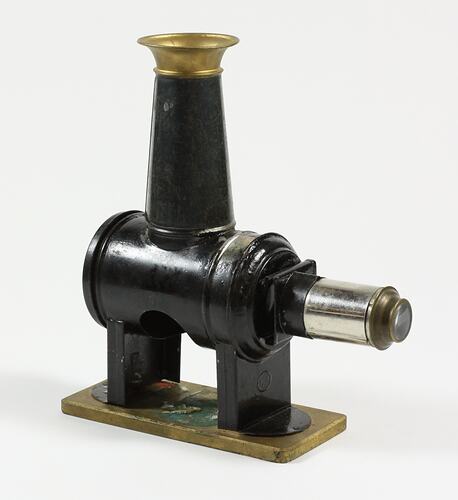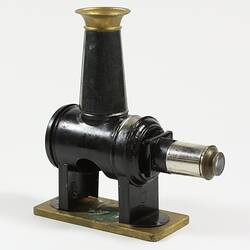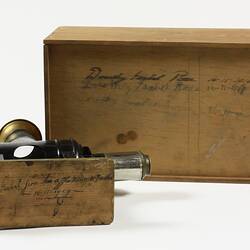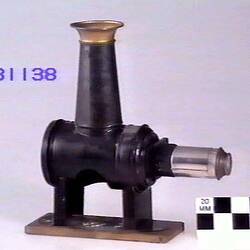Summary
Children's toy magic lantern projector, designed for domestic use with miniature glass slides. Originally the projector would have come in a box and included lantern slides. The illuminant could possibly be a candle or a paraffin or similar burner.
Ernst Plank, the manufacturer was founded in 1866 and produced tin toy trains and boats, as well as magic lanterns. At one time it was the second largest manufacturer of magic lanterns in Nuremberg, Germany. Nuremberg was a major centre for metal toy production and export in the latter part of the 19th century and up to World War I.
While the invention of the magic lantern is generally seen to be in the 17th century, its greatest popularity as an optical projector spans the late 18th Century to the early decades of the 20th Century. It was used both as a means of entertainment and education.
Physical Description
Barrel shaped black enamel projector. Removable funnel chimney with gilt painted flared top. Circular bottom-hinged back door into illumination chamber. Illuminant missing. Removable two part nude metal lens tube with brass covering to single lens. Feet fixed to gilt coloured rectangular wooden base. Underside of lantern body has cutout to accommodate illuminant. Base underneath cutout has remnant wax. Embossed maker's logo to front foot. Some chipping of black enamel on front top of body. Lantern has wooden storage box with sliding lid.
More Information
-
Collecting Areas
-
Acquisition Information
Donation from Mrs L. Pile, 22 Aug 1979
-
Manufacturer
Ernst Plank, Nuremberg, Bavaria, Germany, 1890-1925
!925 is an approximate date; their export market was affected by the First World War. -
Inscriptions
Embossed maker's mark on front foot: 'EP'? Handwritten of box lid: 'Dorothy Isabel Rose 16-11-1919/Dorothy Isabel Rose 16-11-1919/Dorothy Isabel Rose 16 11-1919' Handwritten on underside of base: 'To Isabel from her affectionate Father 16.11.1919'
-
Classification
-
Category
-
Discipline
-
Type of item
-
Overall Dimensions
220 mm (Length), 80 mm (Width), 245 mm (Height)
Object Dimensions with Chimney
-
References
[Book] Robinson, David, et al. 2001. Encyclopaedia of the Magic Lantern., 235 Pages
-
Keywords



